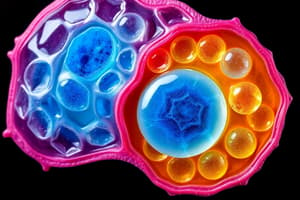Podcast
Questions and Answers
Which of the following is not a type of tissue? (Select all that apply)
Which of the following is not a type of tissue? (Select all that apply)
- Epithelial
- Nervous
- Muscle
- Embryonic (correct)
The process by which a less specialized cell matures into a more specialized cell is called ________.
The process by which a less specialized cell matures into a more specialized cell is called ________.
differentiation
Differentiated cells in a developing embryo derive from ________.
Differentiated cells in a developing embryo derive from ________.
- Endothelium, mesothelium, and epithelium
- Epidermis, mesoderm, and endothelium
- Connective tissue, epithelial tissue, and muscle tissue
- Ectoderm, mesoderm, and endoderm (correct)
Which of the following lines the body cavities exposed to the external environment?
Which of the following lines the body cavities exposed to the external environment?
Identify the four types of tissue in the body.
Identify the four types of tissue in the body.
Describe the major functions of the four tissue types.
Describe the major functions of the four tissue types.
Describe the transition of the zygote from totipotent to specialized cells.
Describe the transition of the zygote from totipotent to specialized cells.
What is the function of synovial membranes?
What is the function of synovial membranes?
What is connective tissue?
What is connective tissue?
What is a connective tissue membrane?
What is a connective tissue membrane?
What is cutaneous membrane?
What is cutaneous membrane?
What is ectoderm?
What is ectoderm?
What is endoderm?
What is endoderm?
What is an epithelial membrane?
What is an epithelial membrane?
What is epithelial tissue?
What is epithelial tissue?
What is histology?
What is histology?
What is lamina propria?
What is lamina propria?
What is mesoderm?
What is mesoderm?
What is mucous membrane?
What is mucous membrane?
What is muscle tissue?
What is muscle tissue?
What is nervous tissue?
What is nervous tissue?
What is serous membrane?
What is serous membrane?
What is synovial membrane?
What is synovial membrane?
What is tissue?
What is tissue?
What is a tissue membrane?
What is a tissue membrane?
What is totipotent?
What is totipotent?
Flashcards are hidden until you start studying
Study Notes
Types of Tissue
- Four main types of tissue: epithelial, connective, muscle, and nervous.
- Epithelial tissue functions in protection, absorption, transport, and secretion; it covers surfaces and lines cavities.
- Connective tissue provides support, binds organs, and integrates body systems; it includes various forms and membranes.
- Muscle tissue enables movement through contraction; it consists of skeletal, smooth, and cardiac types.
- Nervous tissue transmits signals as electrochemical impulses, facilitating communication within the body.
Tissue Differentiation
- Differentiation is the process where less specialized cells mature into specialized types.
- Cells in developing embryos originate from three primary germ layers: ectoderm, mesoderm, and endoderm.
- The zygote is totipotent, forming all body cells, including specialized cells like neurons through differentiation stages.
Embryonic Germ Layers
- Ectoderm: Outermost layer; develops into epidermis and nervous tissue.
- Mesoderm: Middle layer; forms connective tissues, muscle tissues, and some epithelial tissues.
- Endoderm: Innermost layer; gives rise to most of the digestive and lower respiratory systems.
Types of Membranes
- Mucous membranes: Line cavities exposed to the external environment and are protected by mucus.
- Synovial membranes: Connective tissue that supports joint mobility and produces lubricating synovial fluid.
- Serous membranes: Line body cavities and are lubricated with serous fluid to reduce friction.
- Cutaneous membrane: The skin, composed of stratified squamous epithelial cells.
Histology
- Histology is the microscopic study of tissue architecture and organization, crucial for understanding tissue function and pathology.
Cell Types and Functions
- Fibroblasts in connective tissue membranes produce hyaluronan, essential for synovial fluid production, enhancing joint movement.
- Connective tissue membranes encapsulate organs and line movable joints, providing structural support.
Totipotent Cells
- Totipotent cells can differentiate into any cell type, enabling the formation of all tissues and organs during development.
Studying That Suits You
Use AI to generate personalized quizzes and flashcards to suit your learning preferences.




